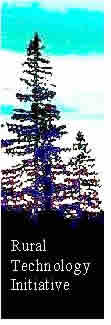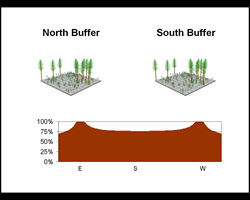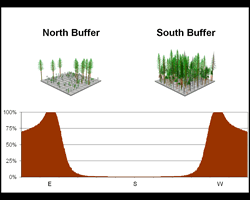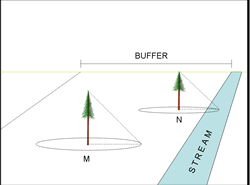 |
 |
 |
 |


Spring 2002, Vol. 2, No. 2
Table of Contents:Director's Notes: by Bruce Lippke
|
| alternative planning
process that is possible under the rules. While you will note
that the alternative planning process also has significant problems
that would appear to limit its potential, it does provide a
directional blueprint for reducing the negative economic impacts
on small owners as well as improving the certainty of achieving
the ecological objectives that were the intent of the regulations.
The first article summarizes what was learned from the case studies and the problems that appear to be limiting the benefits that might be possible from an approved alternative plan. Since the approval of an alternative plan will be dependent upon showing that the plan provides at least as much protection as the buffer protection provided by the rules, an important aspect of alternative plans will be the demonstration of equivalent protection. The second article shows how some of the more important impacts of management on riparian functions can be modeled to support the development of alternative plans and the identification of best management practices. Comparing the impact of an alternative plan on shade and Large Wood Recruitment (LWD) potential with the impacts from management under the regulation can go a long way to showing equivalent or better |
Bruce Lippke, Director
|
|
RTI’s objective is to use better
technology to manage forests in rural areas for increased
product and environmental values in support of local communities.
|
| Alternate plans may provide solutions
that offer economic relief to landowners as well as riparian
habitat improvement opportunities. Landowners are allowed to
deviate from the Forests and Fish Rules and manage under an
approved alternate plan if it meets or exceeds the level of
resource protection provided by the default rules. Only a handful
of landowners have applied for alternate plans so far. The process
is still in its infancy, and guidelines are not yet well established.
RTI is working with both an Eastside and Westside landowner
who have applied for alternate plans. The Westside landowner
has young, overstocked riparian stands. The proposed plan
would allow successive thinnings all the way to the stream.
This would recover some value for the landowner and improve
the growth of the residual stand to enhance riparian function.
The Eastside landowner has overstocked riparian stands that
are stagnating. The proposed plan in this case would allow
for selective removal of stagnant, small-diameter stems. The
riparian zone would then be harvested sequentially in sections
(to reduce impacts) and restocked with fire-resistant species
that were dominant in earlier times. |
Another challenge with alternate
plans is the approval process. The current process is very onerous
and time-consuming for both the landowner and the Department
of Natural Resources. Thus, implementing alternate plans for
more than a few landowners per year may not be realistic. In
addition to the time involved in the approval process, a significant
amount of data and technical expertise is needed to make a case
for an alternate plan. This can make the approval process itself
very costly for the landowner, which offsets any economic relief
from the plan. Despite these challenges, alternate plans may be setting a directional pathway for providing economic relief to landowners and enhancing riparian habitat on private lands. These alternatives are very important, as they represent the only approach under current consideration that might maintain forest management on these lands. In order for this approach to become a viable solution, though, policy changes are needed to streamline the approval process and allow for comprehensive, long-term plans. The Forest Practices Board has already recognized this, and they are investigating the possibility of creating alternate plan templates. These would be a set of “off the shelf” plans to cover common situations such as young, overstocked stands or hardwood conversion. RTI is also working to assist landowners with the alternate
plan process. Featured in this newsletter are several new
computer models which have been developed to help assess alternate
plans in terms of shade, large woody debris recruitment, and
stand structure. These models can be used to support landowners
who are proposing alternate plans, and they can also be used
to support the creation of templates. |
RTI Technology Training |
 |
|
| RTI offers affordable training opportunities throughout the year to non-industrial forest landowners, tribal foresters, consultants, rural educators, and other interested parties in the use of geographical positioning systems (GPS), geographical information systems (GIS), and the Landscape Management System (LMS). All training workshops are certified for Continuing Forestry Education credits by the Society of American Foresters. |
The following training opportunities are scheduled for the months ahead:
For more information or to register visit the calendar page of the web site at www.ruraltech.org |
landing in a stream should it fall. Figure 4 illustrates
how those trees whose height is less than their distance from
the stream (tree M) have a zero probability of recruitment.
Only those trees whose height is greater than their distance
from the stream (tree N) have a positive probability of recruitment;
the probability is equal to the proportion of the tree’s
fall space (the circle centered on the tree) that overlaps the
stream.
The output of the LWD model is the expected potential recruitment
from a forest inventory contained in a buffer of given dimensions.
Figure 5 illustrates the marginal and cumulative recruitment
potential for a sample stand that is 200 feet wide and spans
750 feet of stream reach. Note that 90 percent of all recruitment
is achieved within the first 100 feet of the stream; while
no recruitments are expected beyond 140 feet.
|
By developing best management plans for a number of typical site conditions, it may be feasible to develop templates that make the decision process easier. --Jason Cross has an MS in Silviculture. Northwest Folklife FestivalThe 2002 Northwest Folklife Festival, a celebration of ethnic, folk, and traditional arts and crafts, brought forestry to the Seattle Center with the “East meets West, Forests and Woodlands” theme. The success was greatly helped by the collaborative efforts of the Washington Farm Forestry Association, Washington Forest Protection Association, Washington State Society of American Foresters and UW College of Forest Resources with booths providing educational information on forests and forestry in Washington State. Demonstrations of old-time logging skills, such as crosscut
sawing, wood chopping, log rolling, tree climbing and tree
topping drew some of the largest crowds of the weekend. Participants
from Washington and Idaho included University of Washington
Logging Sports Team coaches Gordy Mauhl, of Carnation, WA,
and Ed “Mooch” Smith, of Eatonville, WA, with Diane
Ellison, small forest landowner and former World Champion
logroller from Grays Harbor County, emceeing the demonstrations.
Gordy Mauhl and Dave Moses, Sr. springboard
chopping at the Folklife 2002 logging sports demonstration.
Do you have Something to Say?By going to the newly added RTI response page, you can post any questions, comments and/or suggestions you may have about our website, activities, or any other aspect of the Rural Technology Initiative. Through this feedback we hope to be able to better tailor our website and activities to meet the needs of YOU, our audience.
|
|
variability of the desired forest structures and allowing
the use of multiple characteristics to describe these structures.
An assessment procedure of this sort will better identify
the desired forest structures, better discriminate between
desirable and undesirable forest structures, and provide more
management flexibility than an assessment procedure limited
to a single characteristic described by its average value.
Example: An example demonstrating the target definition
method is shown in Figure 1. In this example, a sample of
127 old-growth riparian stands is plotted by two structural
characteristics: stand density (TPA) and quadratic mean diameter
(QMD). QMD, the diameter of a tree with the average basal
area, combined with TPA, reveals both density and structural
characteristics. The sample includes 89 stands used to develop
the basis for the desired future conditions (DFC) basal area
targets in the Forests and Fish Rules. The target in this
example is defined by 17 stands between the ages of 120 and
160 years, and is represented as black dots in Figure 1. The
target stands overlap the central portion of the larger data
set, where most of the stands are located, and they should
provide for a good target definition. A target for use in
the alternate planning process would use the majority of the
available old-growth riparian stands, not just the 17 points
used here to illustrate the ideas.
Figure 2 shows results from the application of the assessment procedure using the target and observation data from Figure 1. Stands identified as acceptable by the assessment procedure are those that are statistically indistinguishable from the target. The bulk of the stands, located around the elbow of the data, are considered acceptable, as should be expected. The unacceptable stands appear in the two tails: low density stands with very large trees and high-density stands with small trees. The former stands, though biologically desirable as old-growth, fall outside the realm of possibility for managed forest stands using the 140 year time horizon defined by the Forests and Fish Rules. Continued down to next page |
The high density stands represent a biologically
undesirable stand condition that will most likely not develop
the desired old-growth-like structures.
It is important to note that for these riparian stands, the desirable condition cannot be distinguished from the undesirable condition using basal area alone. Many managed riparian stands are currently over stocked, as they were being managed with the expectation that they would be thinned. They are representative of undesirable stands with high densities and small trees. It is likely that thinning activities not contemplated under the default Forests and Fish Rules could better duplicate the desired forest structures than management under the default rules, while at the same time reducing costs. By using two stand characteristics (TPA and QMD) simultaneously to provide more information, a better representation of the forest structure is obtained, allowing stands that are desirable or undesirable to be more easily distinguished from one another. In contrast to the DFC basal area targets in the Forests and Fish Rules, the riparian forest management targets described here define a desired target, regardless of the age at which that structure is achieved. Obtaining the desired forest structure sooner may be more beneficial both ecologically and economically than obtaining it later. By emphasizing forest structure, incorporating the inherent variability, and using multiple stand characteristics to describe the desired forest structure, we can more reliably assess management options that could obtain the desired structural conditions. These target definition and assessment procedures may be used to provide a scientifically rigorous evaluation of potential alternate plans. The incorporation of natural variability via the distribution of riparian stand structural characteristics permits the use of well-accepted statistical techniques and concepts to produce compatible approaches for target definition and assessment. The use of multiple stand characteristics to define a target provides more information about stand structure than a single characteristic, increasing the discriminatory power, and making it easier to identify alternate plans that will obtain the desired forest conditions. |
The use of stand characteristics from actual old-growth
riparian forest stands in these procedures allows us to identify
desired conditions based on “real world” conditions.
Finally, defining management targets based on forest structure
rather than a specific stand age places a greater emphasis on
forest biology, as represented by the stand characteristics
used to define a target and assess potential alternate plans.
This process may be reducible to simple templates. By evaluating
a number of typical stand situations under a range of alternate
plans, it may be practical to develop templates for many current
stand conditions. Templates will simplify predictions of acceptable
and unacceptable alternate plans, making it possible to streamline
the approval process, create greater management flexibility,
assume achievement of desired future conditions, and reduce
costs to landowners. Washington State DNR Small Forest Landowner Database, 2002Last year, RTI working as a contractor to the Small Forest Landowners Office (SFLO) of the Department of Natural Resources completed the first phase of a project to gather and analyze available tax data on lands in Washington designated as non-industrial forests. Some of the demographic insights from this land use analysis were presented in the Fall 2001 publication of the RTI Newsletter. Findings have been outlined as well in a broader report that was prepared by the Small Fores Landowner Office of the DNR and submitted to the state legislature. The second phase of the Small Forest Landowner Database project has been to develop and demonstrate a methodology for validating land use status results using remote sensing technology. Better information on land owner demographics will help the State Legislature to better understand the critical role that small forestland ownership plays in the future of Washington State.Clark, King, and Whatcom counties were selected as three of the western Washington counties that have the most accurate data and Geographic Information Systems (GIS) capabilities. Using ArcGIS®, RTI analysts have been able to utilize the counties’ parcel data in conjunction with LANDSAT and high definition aerial photos (orthophotos). This combination of tabular and spatial data allows a visual comparison of forested and non-forested land against status as filed in tax records. Since 100’s of 1000’s of parcels must be examined during this validation process, a typing system has been designed to enable a computer program to identify and record the forested attributes from satellite images and orthophotos and to then determine accuracy in the tax records. RTI is nearing full verification of the land use parcel data from Clark, King and Whatcom counties. Further phases of this project, pending funding availability, are anticipated for the assessment of data from other counties. RTI image technology will be available for other remote sensing applications such as aerial analysis of insect infestations, forest fire risk, or land use conversion trends. |






 Figure 5: Visualization and
recruitment
Figure 5: Visualization and
recruitment 



